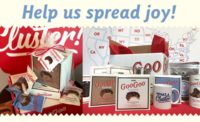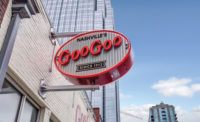
It was the late 19th century British novelist Edward Bulwer Lytton who came up with the metaphor of “forcing a square peg into a round hole.” Although rarely used today, the idiom used to be a battle cry for individualism versus conformity several decades ago.
In Standard Candy Co.’s case, the square peg round hole analogy could mean the revitalization of one of this nation’s oldest brands – Goo Goo Clusters.
Developed in 1912 by Howard Campbell, Jr., the round mound of caramel, marshmallow, fresh roasted peanuts and pure milk chocolate claims to be the world’s first ever combination candy bar.
Moreover, it defied conformity – and traditional wrapping machines – by being shaped as an irregular round piece. That, coupled with a wonderful mix of quality ingredients, quickly made it a local and eventually a national favorite for years to come.
Despite the onslaught of automation and technology during the 20th century, Goo Goo Clusters remained a production manager’s challenge. As Neal Spradley, vice president of Nashville-based Standard Candy Co., relates, when Jimmy Spradley, Neal’s brother, acquired Standard Candy Co. in 1982., the preparation and processing time took about five days, despite using an automated starch-moulding machine to produce a marshmallow centers.
“Our goal was focused on speeding up the process, reducing it from five to three to two days to even 24 hours,” he says. In the end though, the costs associated with producing Goo Goo Clusters didn’t leave much room for profit margins in a retail arena focused on low-cost treats.
In the interim, Standard Candy Co. formed a new contract manufacturing subsidiary, Standard Function Food, in 1999. Gradually, the emphasis moved away from branded products, such as Goo Goo Clusters and Cumberland Ridge Pecan Rolls.
At its peak in the early 1980s, Goo Goo Cluster sales approached $30 million across a broad range of retail outlets throughout the United States. The volume, nevertheless, failed to reflect production and marketplace challenges.
Retailers sought inexpensive candies. Despite ongoing improvements, the starch moulding marshmallow process didn’t deliver sought-after efficiencies.
Moreover, the contract manufacturing side of Standard Candy’s operations continued to grow.
“Sales started to slip and there was little attention paid to the brand,” explains Jimmy. “Contract manufacturing took over.”
Enter Lance Paine. Formerly with La Brea Bakery and Wholesale Dessert Bakery, Paine had extensive experience in bakery food marketing. Having sold his interest in Wholesale Dessert, Paine was searching for another opportunity.
An investment baker suggested a breakfast meeting with Jimmy. The two met in May and quickly found common ground, which led to Paine developing a business plan for the revitalization of Goo Goo Clusters.
On September 2010, Goo Goo Clusters, LLC was formed as a separate subsidiary of Standard Candy Co. Paine became its executive vice president charged with bringing the gloried candy brand back.
As Paine notes, “Goo Goo Clusters had become somewhat of the red-haired stepchild. Both Jimmy and I thought that if it was treated as a contract customer by the company that would change the way the brand was viewed internally.
“It’s important to remember that Goo Goo Clusters are a quality product, and that it’s made in America,” he continues. “The company was selling this at a discount, forgetting that it costs to make this product.”
It was quickly apparent to Paine that customers needed to be reminded of how high quality Goo Goo Clusters actually were. In addition, to ensure a broader acceptance of the product amongst consumers and customers, a review of the ingredient label delivered a clear upgrade.
“We no longer use vanillin; we simply buy better chocolate,” says Paine. “In the past, we used pecans with wheat germ. Today, it’s all pecan slivers.
“Also, keep in mind that this company has been making Goo Goo Clusters for nearly 100 years. It’s been people from middle Tennessee putting their blood, sweat and tears into the product. We want to celebrate this fact more.”
Given that the brand will celebrate it’s 100th anniversary next year, the timing’s ideal to kick off such a campaign.
But to ensure that the marketing push dovetailed with a targeted sales effort, it was critical that production challenges be addressed – and this is where the square peg round hole analogy comes into play again.
By capitalizing on existing slab bar technology, the company was able to convert a labor-intensive, batch process into a highly efficient, continuous slab line production process.
Instead of waiting on the production of marshmallow centers, marshmallow mass cooked in the kitchen is poured into a hopper that feeds a Lloveras BK bar line. The marshmallow base comes off a cooling drum and travels along a non-stick belt. A caramel layer is added to the base, the two layers compressed and chilled before they are slit into 13 rows.
Once the rows gradually separate, they move toward a guillotine cutter that produces 2-in. squares. The squares are aligned and then head toward the first of two enrobing units.
Once a layer of milk chocolate is deposited, squares continue forward passing under a nut seeder. The seeded nut squares begin to take a rounded shape as they move toward the second enrobing unit.
The second chocolate bath “rounds” out the square cluster before a prolonged march in the cooling tunnel. After cooling, the clusters head toward one of three flow-wrapping machines, each capable of handling 200 units per minute.
As Neal relates, it took about a year to fine-tune the production of Goo Goo Clusters on a slab line. One of the challenges the production team faced was making squares into round mounds. But thanks to “pliable ingredients,” the team resolved the issue.
The biggest test, however, involved comparing old-style Goo Goo Clusters to slab bar-produced pieces
“It had to be a side-by-side comparison, one whereby you couldn’t tell the difference,” he says.
Suffice it to say that the new method Goo Goo Clusters passed the test with aplomb, both from blind tasting as well as efficiency requirements. Today, the company produces about 30,000 clusters an hour.
During this same time frame, Paine continued to work on expanding the sales and marketing reach.
As he explains, it was important to reach out to existing customers – Cracker Barrel (600 restaurants) and Tractor Supply Co. (1,000 stores) – and explain the positioning shift. The upgrading of ingredients necessitated a price increase. It also meant a better product, one that would be supported by an ever-widening marketing campaign. Both customers backed the strategy.
First, as Paine explains, the marketing effort will focus on home turf. As he points out, the city gets 10 million visitors each year.
Thus, this March, at the Nashville International airport, there will be ads for Goo Goo Clusters by the baggage claim area. Paine is currently looking at initiatives to get Goo Goo Clusters sponsorships in LP Field, home of the Tennessee Titans pro football team, and Herschel Greer Stadium, home to the Triple-A baseball team, the Nashville Sounds.
The program gradually will expand south as the company begins to focus on Southern supermarket and drug store chains to re-introduce Goo Goo Clusters into the mainstream.
In April, a new Web site will debut for Goo Goo Clusters. Here too, Paine looks to generate excitement through social media initiatives, one of which involves bloggers.
“We’re looking to include bloggers who have high Klout scores [Klout is a measurement of influence derived from Facebook and Twitter],” he says. “Take for example, Beth Eats [www.eat-drink-smile.com]; there are people that trust her implicitly.”
As a result, Paine is investigating the idea of sponsoring bloggers to get the word out about the confection.
“Candy is such an experiential thing; it has a life force beyond the candy aisle,” he adds.
To build on that life force, Paine has moved to tweaking the graphics associated with Goo Goo Clusters. First, the logo was stylized slightly to contemporize it.
The packaging also is getting a face lift, moving from a photograph of the product to an illustration.
It’s not exactly a “retro” look, or a return to nostalgia, Paine says. Rather, it’s simply more reflective of the brand’s heritage.
The film used for the new packaging also will be 100% compostable with a matte film finish. Even the cartons will be made from uncoated stock.
“We’re also purchasing renewable energy credits,” he says. Renewable energy credits (RECs), also known as green tags or renewable energy certificates, are tradable, non-tangible energy commodities that represent proof that 1 megawatt-hour of electricity was generated from an eligible renewable energy resource. In this instance, GGC LLC is purchasing kilowatt hours generated from a wind farm in Texas.
Interestingly, all of these initiatives – better quality, a cleaner ingredient statement, compostable film, a smaller carbon footprint – represent part of the new sustainable American corporate culture.
For Goo Goo Clusters, LLC, this twist on a century-old heritage dovetails perfectly with another American tradition: comebacks.
Child’s Play – Choosing a name
Reportedly, there are quite a few variations to the story of how Goo Goo Clusters received such an unusual name. According to the company, the inventor of Goo Goo Clusters, Howard Campbell, used to ride a streetcar to work. Soon after he developed his delicious new confection, word spread quickly about this uniquely round-shaped treat. People didn’t know how to ask for or what to call it. Campbell was extremely excited that his newest concoction was the talk of the town, but even he, himself was baffled as to what to call his latest creation. One day Campbell was announcing to fellow passengers on the streetcar his newborn son’s first words and a school teacher made the connection with the candy. She suggested that the confectioner name his treat “Goo Goo!”
Why? “It is so good, people will ask for it from birth.”
At a glance:
Standard Candy Co.
Headquarters: Nashville
Subsidiaries: Goo Goo Clusters, LLC, Standard Functional Food Co.
Sales: $100 million (Candy Industry estimate)
Employees: 700
Plant: 100,000 sq. ft; five production lines
Warehousing: 150,000 sq. ft.
Brands: Goo Goo Clusters
Management: Jimmy Spradley, president, Neal Spradley, vice president, Tom Drummond, v.p. – manufacturing; Lance Paine, executive v.p. – Goo Goo Clusters, LLC.



